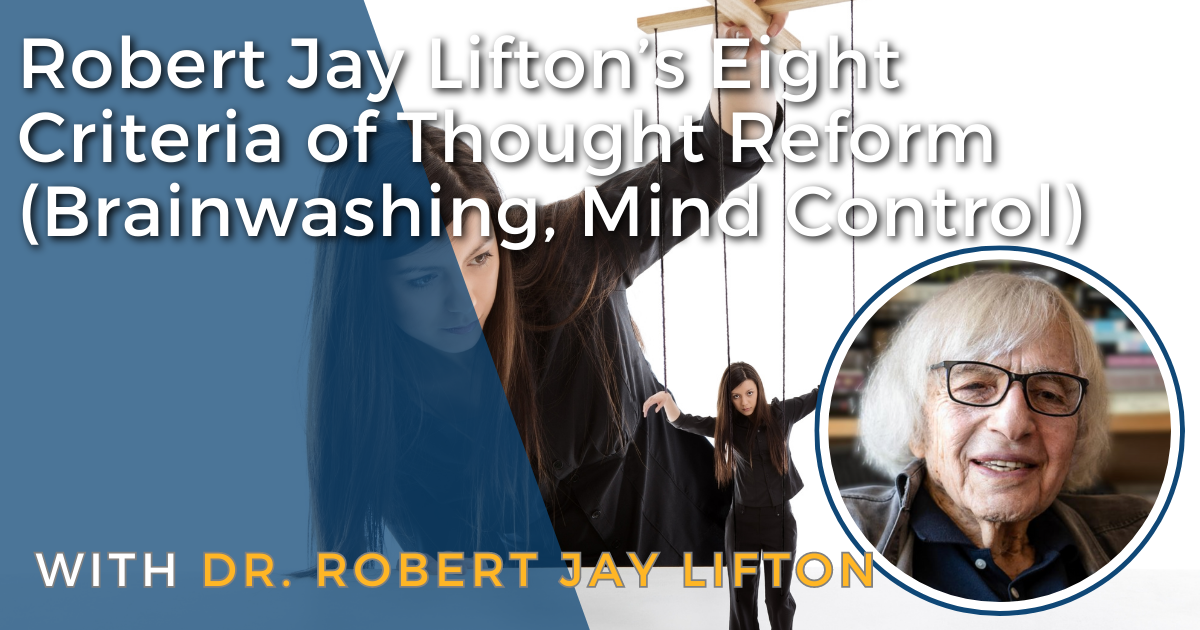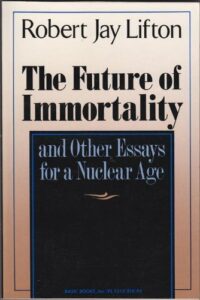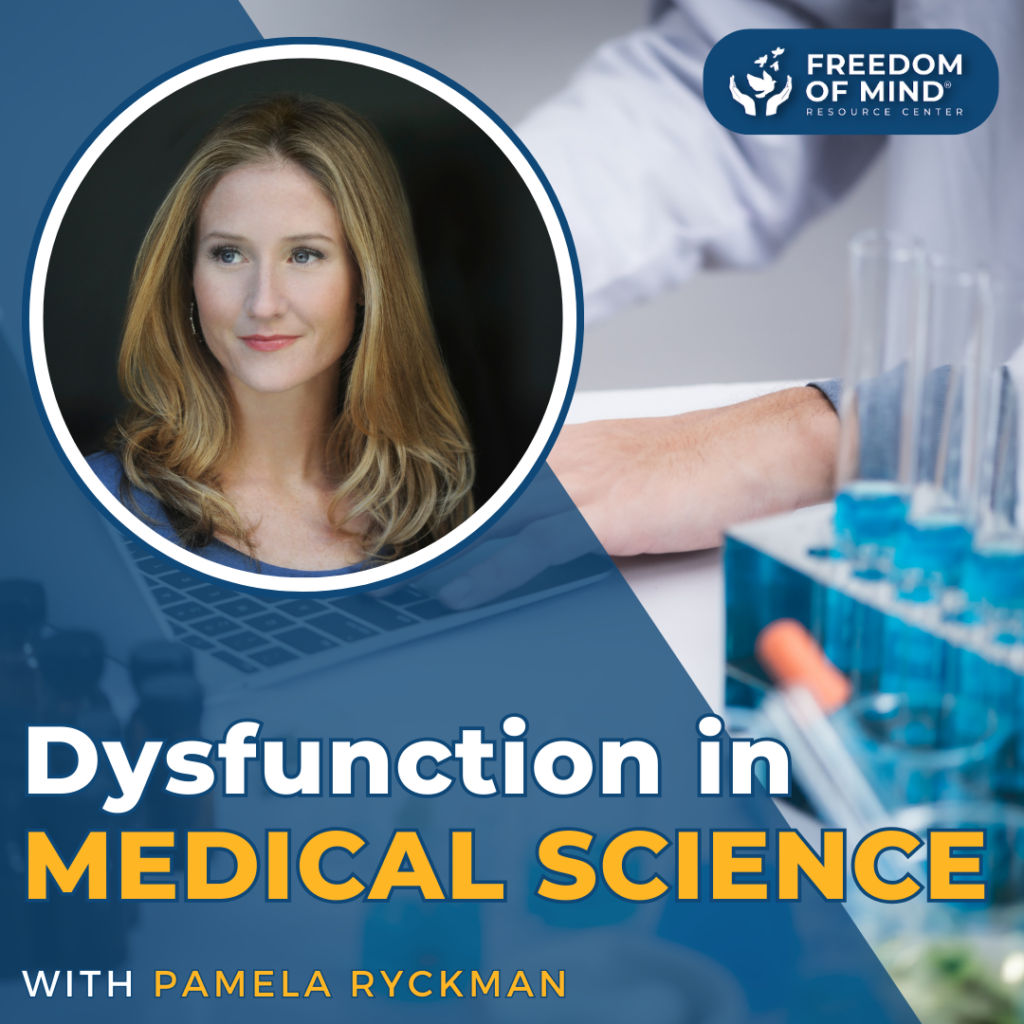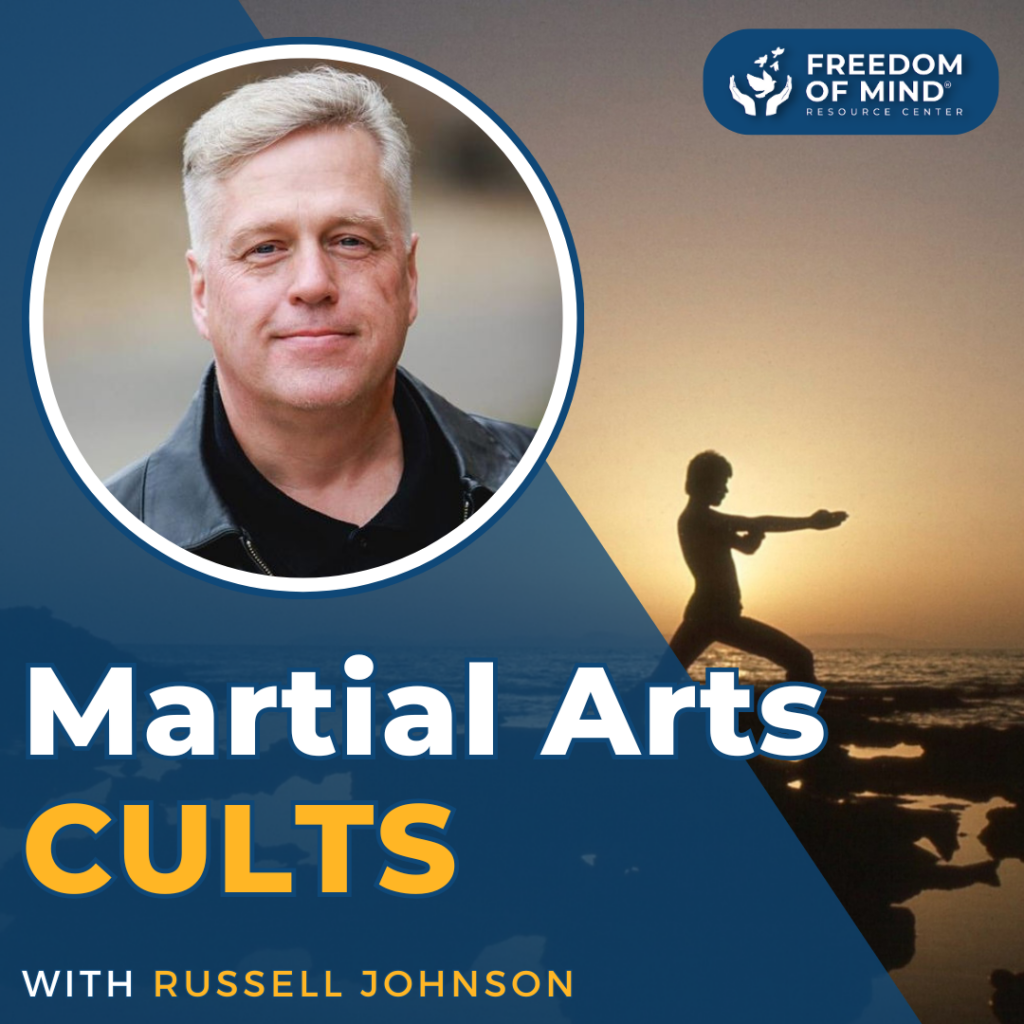
 The following excerpt is used with permission from Robert Jay Lifton’s The Future of Immortality and Other Essays for a Nuclear Age (New York, Basic Books, 1987) is a concise explanation of Lifton’s eight criteria for defining mind control. His 1961 book, Thought Reform and the Psychology of Totalism: A Study of “Brainwashing” in China was instrumental in my deprogramming form the Moon cult in 1976. I thought it is long overdue for me to have a full exposition of his ideas presented in his “Chapter 22” of this seminal work. In particular, Chinese “re-education” programs are being used on a reported one million Uighur Muslims today. The Chinese are also reportedly using these programs are government dissidents as well as Christians, buddhists, Jehovah’s Witnesses, Falun Gong and others they feel threaten their hegemony. I feel it is of vital importance for everyone but especially those concerned about Chinese authoritarianism to understand the Lifton model.
The following excerpt is used with permission from Robert Jay Lifton’s The Future of Immortality and Other Essays for a Nuclear Age (New York, Basic Books, 1987) is a concise explanation of Lifton’s eight criteria for defining mind control. His 1961 book, Thought Reform and the Psychology of Totalism: A Study of “Brainwashing” in China was instrumental in my deprogramming form the Moon cult in 1976. I thought it is long overdue for me to have a full exposition of his ideas presented in his “Chapter 22” of this seminal work. In particular, Chinese “re-education” programs are being used on a reported one million Uighur Muslims today. The Chinese are also reportedly using these programs are government dissidents as well as Christians, buddhists, Jehovah’s Witnesses, Falun Gong and others they feel threaten their hegemony. I feel it is of vital importance for everyone but especially those concerned about Chinese authoritarianism to understand the Lifton model.
These criteria are:
- Milieu control
- Mystical manipulation (or planned spontaneity)
- The demand for purity
- The cult of confession
- Sacred science
- Loading of the language
- Doctrine over person
- Dispensing of existence
The essay from which this selection is taken is entitled “Cults: Religious Totalism and Civil Liberties.” In it, Lifton frames his comments in relation to what he calls ideological totalism. This was the environment in which Chinese thought reform was practiced, as Lifton came to know of it from the Korean War and afterward.
IDEOLOGICAL TOTALISM
The phenomenology I used when writing about ideological totalism in the past still seems useful to me, even though I wrote that book in 1960. The first characteristic is “milieu control,” which is essentially the control of communication within an environment. If the control is extremely intense, it becomes an internalized control—an attempt to manage an individual’s inner communication. This can never be fully achieved, but it can go rather far. It is what sometimes has been called a “God’s-eye view”—a conviction that reality is the group’s exclusive possession. Clearly, this kind of process creates conflicts in respect to individual autonomy: if sought or realized in such an environment, autonomy becomes a threat to milieu control. Milieu control within cults tends to be maintained and expressed in several ways: group process, isolation from other people, psychological pressure, geographical distance or unavailability of transportation, and sometimes physical pressure. There is often a sequence of events, such as seminars, lectures, and group encounters, which becomes increasingly intense and increasingly isolated, making it extremely difficult—both physically and psychologically—for one to leave.
These cults differ from patterns of totalism in other societies. For instance, the centers that were used for reform in China were more or less in keeping with the ethos of the society as it was evolving at the time: and therefore when one was leaving them or moving in and out of them, one would still find reinforcement from without. Cults, in contrast, tend to become islands of totalism within a larger society that is on the whole antagonistic to these islands. This situation can create a dynamic of its own; and insofar as milieu control is to be maintained, the requirements are magnified by that structural situation. Cult leaders must often deepen their control and manage the environment more systematically, and sometimes with greater intensity, in order to maintain that island of totalism within the antagonistic outer world.
The imposition of intense milieu control is closely connected to the process of change. (This partly explains why there can be a sudden lifting of the cult identity when a young person who has been in a cult for some time is abruptly exposed to outside, alternative influences.) One can almost observe the process in some young people who undergo a dramatic change in their prior identity, whatever it was, to an intense embrace of a cult’s belief system and group structure. I consider this a form of doubling: a second self is formed that lives side by side with the prior self, somewhat autonomously from it. Obviously there must be some connecting element to integrate oneself with the other—otherwise, the overall person could not function; but the autonomy of each is impressive. When the milieu control is lifted by removing, by whatever means, the recruit from the totalistic environment, something of the earlier self reasserts itself. This leave-taking may occur voluntarily or through force (or simply, as in one court case, by the cult member moving across to the other side of the table, away from other members). The two selves can exist simultaneously and confusedly for a considerable time, and it may be that the transition periods are the most intense and psychologically painful, as well as the most potentially harmful.
A second general characteristic of totalistic environments is what I call “mystical manipulation” or “planned spontaneity.” It is a systematic process that is planned and managed from above (by the leadership) but appears to have arisen spontaneously within the environment. The process need not feel like manipulation, which raises important philosophical questions. Some aspects—such as fasting, chanting, and limited sleep—have a certain tradition and have been practiced by religious groups over the centuries. There is a cult pattern now in which a particular “chosen” human being is seen as a savior or a source of salvation. Mystical manipulation can take on a special quality in these cults because the leaders become mediators for God. The God-centered principles can be put forcibly and claimed exclusively so that the cult and its beliefs become the only true path to salvation. This can give intensity to the mystical manipulation and justify those involved with promulgating it and, in many cases, those who are its recipients from below.
Insofar as there is a specific individual, a leader, who becomes the center of the mystical manipulation (or the person in whose name it is done), there is a twofold process at work. The leader can sometimes be more real than an abstract god and therefore attractive to cult members. On the other hand, that person can also be a source of disillusionment. If one believes, as has been charged, that Sun Myung Moon (founder of the Unification Church, whose members are consequently referred to frequently as “Moonies”) has associations with the Korean Central Intelligence Agency and this information is made available to people in the Unification Church, their relationship to the church can be threatened by disillusionment toward a leader. It is never quite that simple a pattern of cause and effect—but I am suggesting that this style of leadership has both advantages and disadvantages in terms of cult loyalty.
While mystical manipulation leads (in cult members) to what I have called the psychology of the pawn, it can also include a legitimation of deception (of outsiders)—the “heavenly deception” of the Unification Church, although there are analogous patterns in other cult environments. If one has not seen the light, and it is not in the realm of the cult, one is in the realm of evil and therefore can be justifiably deceived for the higher purpose. For instance, when members of certain cults have collected funds, it has sometimes been considered right for them to deny their affiliation when asked. Young people have been at centers of a particular cult for some time without being told that these were indeed run by it. The totalistic ideology can and often does justify such deception.
The next two characteristics of totalism, the “demand for purity” and the “cult of confession,” are familiar. The demand for purity can create a Manichean quality in cults, as in some other religious and political groups. Such a demand calls for radical separation of pure and impure, of good and evil, within an environment and within oneself. Absolute purification is a continuing process. It is often institutionalized; and, as a source of stimulation of guilt and shame, it ties in with the confession process. Ideological movements, at whatever level of intensity, take hold of an individual’s guilt and shame mechanisms to achieve intense influence over the changes he or she undergoes. This is done within a confession process that has its own structure. Sessions in which one confesses to one’s sins are accompanied by patterns of criticism and self-criticism, generally transpiring within small groups and with an active and dynamic thrust toward personal change.
One could say more about the ambiguity and complexity of this process, and Camus (index all) has observed that “authors of confessions write especially to avoid confession, to tell nothing of what they know.” Camus may have exaggerated, but he is correct in suggesting that confessions contain varying mixtures of revelation and concealment. A young person confessing to various sins of precultic or pre-institutional existence can both believe in those sins and be covering over other ideas and feelings that he or she is either unaware of or reluctant to discuss. In some cases, these sins include a continuing identification with one’s prior existence, if such identification has not been successfully dishonored by the confession process. Repetitious confession, then, is often an expression of extreme arrogance in the name of apparent humility. Again Camus: “I practice the profession of penitence, to be able to end up as a judge,” and “the more I accuse myself, the more I have a right to judge you.” That is a central theme in any continual confessional process, particularly where it is required in an enclosed group process.
The next three patterns I describe in regard to ideological totalism are “the sacred science,” the “loading of the language,” and the principle of “doctrine over person.” The phrases are almost self-explanatory. I would emphasize especially sacred science, for in our age something must be scientific as well as spiritual to have a substantial effect on people. Sacred science can offer considerable security to young people because it greatly simplifies the world. The Unification Church is a good example, but not the only one, of a contemporary need to combine a sacred set of dogmatic principles with a claim to a science embodying the truth about human behavior and human psychology. In the case of the Unification Church, this claim to a comprehensive human science is furthered by inviting prominent scholars (who are paid unusually high honoraria) to large symposia that stress unification of thought; participants express their views freely, but nonetheless contribute to the desired aura of intellectual legitimacy.
The term “loading the language” refers to a literalization of language—and to words or images becoming God. A greatly simplified language may seem cliché-ridden, but can have enormous appeal and psychological power in its very simplification. Because every issue in one’s life—and these are often very complicated young lives—can be reduced to a single set of principles that have an inner coherence, one can claim the experience of truth and feel it. Answers are available. Lionel Trilling has called this the “language of nonthought” because there is a cliché and a simple slogan to which the most complex and otherwise difficult questions can be reduced.
The pattern of doctrine over person occurs when there is a conflict between what one feels oneself experiencing and what the doctrine or dogma says one should experience. The internalized message in totalistic environments is that one must find the truth of the dogma and subject one’s experiences to that truth. Often the experience of contradiction, or the admission of that experience, can be immediately associated with guilt; or else (in order to hold one to that doctrine) condemned by others in a way that leads quickly to that guilty association. One is made to feel that doubts are reflections of one’s own evil. Yet doubts can arise; and when conflicts become intense, people can leave. This is the most frequent difficulty of many of the cults: membership may represent more of a problem than money.
Finally, the eighth, and perhaps the most general and significant of these characteristics is what I call the “dispensing of existence.” This principle is usually metaphorical. But if one has an absolute or totalistic vision of truth, then those who have not seen the light—have not embraced that truth, are in some way in the shadows—are bound up with evil, tainted, and do not have the right to exist. There is a “being versus nothingness” dichotomy at work here. Impediments to legitimate being must be pushed away or destroyed. One placed in the second category of not having the right to exist can experience psychologically a tremendous fear of inner extinction or collapse. However, when one is accepted, there can be great satisfaction of feeling oneself a part of the elite. Under more malignant conditions, the dispensing of existence, the absence of the right to exist, can be literalized; people can be put to death because of their alleged doctrinal shortcomings, as has happened in all too many places, including the Soviet Union and Nazi Germany. In the Peoples Temple mass suicide murder in Guyana, a single cult leader could preside over the literal dispensing of existence—or more precisely, nonexistence—by means of a suicidal mystique, he himself had made a part of the group’s ideology. (Subsequent reports based on the results of autopsies reveal that there were probably as many murders as suicides.) The totalistic impulse to draw a sharp line between those who have a right to live and those who do not—though occurring in varying degrees—can become a deadly approach to resolving fundamental human problems. And all such approaches involving totalism or fundamentalism are doubly dangerous in a nuclear age.
I should say that, despite these problems, none of these processes is airtight. One of my purposes in writing about them is to counter the tendency in the culture to deny that such things exist; another purpose is to demystify them, to see them as comprehensible in terms of our understanding of human behavior.
Dr. Lifton wrote Witness to an Extreme Century: A Memoir (Free Press, 2011). Dr. Lifton wrote the foreword to The Dangerous Case of Donald Trump: 37 Psychiatrists and Mental Health Experts Assess a President: Updated and Expanded with New Essays, edited by Dr. Bandy X. Lee.
He has a new book scheduled to come out October 2019, entitled: Losing Reality: On Cults, Cultism, and the Mindset of Political and Religious Zealotry.
I was fortunate to interview Dr. Lifton several times on videotape which is online.
Video Interviews with Robert Jay Lifton, M.D.
- Dr. Robert Jay Lifton and Steven Hassan July 13th 2011
- Dr. Robert Jay Lifton and Steven Hassan: August 2012
- Steven Hassan interviews Robert Jay Lifton, MD 9-17-16 (Part 1/3)
- Steven Hassan interviews Robert Jay Lifton, MD 9-17-16 (Part 2/3)
- Steven Hassan interviews Robert Jay Lifton, MD 9-17-16 (Part 3/3)
Video Blog
Books by Robert Jay Lifton
Losing Reality: On Cults, Cultism, and the Mindset of Political and Religious Zealotry
Witness to an Extreme Century: A Memoir
The Climate Swerve: Reflections on Mind, Hope, and Survival
The Nazi Doctors: Medical Killing and the Psychology of Genocide
Thought Reform and the Psychology of Totalism: A Study of “Brainwashing” in China
Revolutionary Immortality: Mao Tse-tung and the Chinese Cultural Revolution
The Protean Self: Human Resilience in an Age of Fragmentation
Death in Life: Survivors of Hiroshima
Hiroshima in America: Fifty Years of Denial(with Greg Mitchell)
The Genocidal Mentality: Nazi Holocaust and Nuclear Threat(with Erik Marukusen)
Destroying the World to Save It: Aum Shinrikyo, Apocalyptic Violence, and the New Global Terrorism
Indefensible Weapons: The Political and Psychological Case against Nuclearism(with Richard Falk)
Home from the War: Vietnam Veterans – Neither Victims nor Executioners
The Broken Connection: On Death and the Continuity of Life
The Future of Immortality: And Other Essays for a Nuclear Age
Superpower Syndrome: America’s Apocalyptic Confrontation with the World
Who Owns Death: Capital Punishment, the American Conscience, and the End of Executions (with Greg Mitchell)
Six Lives/Six Deaths: Portraits from Modern Japan(with Shuichi Kato and Michael Reich)
The Life of the Self: Toward a New Psychology
Living and Dying(with Eric Olson)
Boundaries: Psychological Man in Revolution
History and Human Survival: Essays on the Young and the Old, Survivors and the Dead, War and Peace, and on Contemporary Psychohistory
Edited Books
Crimes of War: Iraq(with Richard Falk and Irene Gendzier)
In a Dark Time: Images for Survival(with Nicholas Humphrey)
Last Aid: Medical Dimensions of Nuclear War(with E. Chivian, S. Chivian, and J.E. Mack)
Beyond Invisible Walls: The Psychological Legacy of Soviet Traumas(with Jacob D. Lindy)
Crimes of War(with Richard Falk and Gabriel Kolko)
Explorations in Psychohistory: The Wellfleet Papers(with Eric Olson)
America and the Asian Revolutions
The Woman in America




